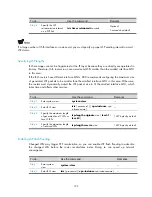
203
To do…
Use the command…
Remarks
Step 4
Set the NSR interval
non-stop-routing interval
interval-
value
Optional
0 seconds by default, that is,
no NSR interval is
configured.
Configuring IS-IS FRR
•
Do not use IS-IS FRR and BFD (for IS-IS) at the same time because IS-IS FRR may fail to take effect.
•
The automatic backup next hop calculation of IS-IS FRR and that of MPLS TE are mutually exclusive; that
is, the
fast-reroute auto
command and the
traffic-eng
command are mutually exclusive.
Introduction
When a link or a router on the IS-IS network fails, the packets on the path are discarded, or a
routing loop occurs until IS-IS completes routing convergence based on the new network
topology.
In such cases, you can enable IS-IS FRR to reduce recovery time.
Figure 65
Network diagram for IS-IS FRR
In Figure 65, after you enable FRR on Router B, IS-IS automatically calculates or designates a
backup next hop when a network failure is detected. In this way, packets are directed to the
backup next hop for forwarding, which greatly reduces traffic recovery time. Meanwhile, IS-IS
calculates the shortest path based on the new network topology, and forwards packets over the
path after network convergence.
You can either enable IS-IS FRR to calculate a backup next hop automatically, or designate a
backup next hop with a routing policy for routes matching specific criteria.
















































